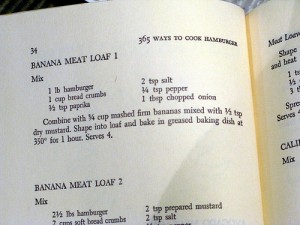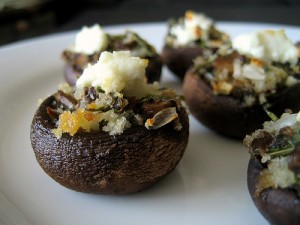One of the first questions every one asks when starting a low oxalate diet is what can I eat? After reading the low oxalate food lists, it’s tempting to think you’ll have to throw out every recipe book you own and start from scratch, but this isn’t true. Many recipes in your collection may be low or medium oxalate, or they can be simply modified to lower the oxalate content. Some recipes may need major revisions. Others are hopeless, but even these may serve as a starting point or catalyst for making up your own low oxalate recipe. Almost every low oxalate recipe I use on a regular basis is one I modified from someone else, or one I made up using a high oxalate recipe as an inspiration.

Is this a Low Oxalate Recipe? Notice this vintage 1960's cookbook actually has two recipes for banana meatloaf! And yes, if banana meatloaf intrigues you as much as it intrigues me (and you use white rice or Odi's gluten-free white bread for your breadcrumbs) this is a low oxalate recipe.
This modifying recipes series is designed to help you gain confidence in determining if your recipes are low oxalate and if not, how to modify them. It is intended for use by low oxalate dieters, but the principals could be used by other dieters who needs to modify recipes to better fit their health needs. All you need is a fairly current database of the oxalate values for foods (see How to get an Accurate Low Oxalate Food List) and a recipe. Let’s get started!
Step One: Is This A Low Oxalate Recipe?
The first thing to ask about any recipe is whether it is low, medium or high oxalate. There are two ways to do this. The first method is easier and faster, and will work fine if you only need a rough estimate of the oxalate content. The second method takes a little math and a little more time, but it has the advantage of allowing you to calculate a close approximation of the actual oxalate content of any recipe.
To show you how they work, let’s look at the ingredient list of a yummy, gluten-free appetizer by Elana Amsterdam of Elana’s Pantry (click the recipe title for the whole recipe).
- 1 (1 pound) package white button mushrooms
- 8 ounces goat cheese
- ¼ cup minced parsley
- 1 tablespoon minced chives
- 1 teaspoons minced garlic
- ¼ teaspoon Celtic sea salt
Method 1: The Guesstimation.
Guess what this method involves? You’re right. Guessing! But it’s educated guessing based on what you know about the oxalate content of each ingredient. To use this method, your recipe has to pass two tests—all ingredients must be low oxalate, very low oxalate or lower medium oxalate AND the recipe cannot contain more than one serving of low oxalate herbs or spices (since the oxalate content in herbs and spices can really add up fast). To use this method, simply check each ingredient to see whether it is very low oxalate (less than 1 mg. per serving), low oxalate (less than 5 mg. oxalate per serving) or “lower medium” oxalate (5-8mg. oxalate per serving), looking up any ingredient you are unfamiliar with in your database. Here’s the list again with each ingredient marked for oxalate content.
- 1 (1 pound) package white button mushrooms (low)
- 8 ounces goat cheese (low)
- ¼ cup minced parsley (low per 1 tablespoon serving)
- 1 tablespoon minced chives (very low)
- 1 teaspoons minced garlic (very low)
- ¼ teaspoon celtic sea salt (very low)
This recipe passes the first test—all ingredients are low or low oxalate. However, it does not pass the second test. Although parsley is low oxalate per serving, this recipe contains four servings of parsley, one serving of chives and one serving of garlic. This means that although all the ingredients are low oxalate, the high amount of herbs might make the recipe medium or even high oxalate.
If your recipe passes both tests, you can feel fairly confident that you have a low oxalate recipe or a lower medium oxalate recipe and can eat this dish on a low oxalate diet. If it fails one or both of the tests, you need more information. Time for method two!
Method 2: Get Precise
In this method, you calculate the approximate oxalate content of one “reasonable” serving of the recipe. First, you must calculate the approximate oxalate content of each ingredient on the list. To do this, you find out how much oxalate is in one serving of ingredient then multiply by how many servings of that ingredient are in the recipe. For example, parsley has 4.5 mg. oxalate per tablespoon, and the recipe calls for 4 tablespoons of parsley (1/4 cup = 4 T), so parsley adds 4.5 X 4 = 18 mg. oxalate to this recipe. Here’s the list again with approximate oxalate contents.
- 1 pound package white button mushrooms (1 pound is about 450 grams, and there’s 4 mg. oxalate per 100 grams of mushrooms. That makes 4 mg. X 4.5 = 18 mg.)
- 8 ounces goat cheese (low oxalate, but no numbers given)
- ¼ cup minced parsley (4.5 mg. X 4 = 18 mg.)
- 1 tablespoon minced chives (0.1 mg.)
- 1 teaspoon minced garlic (0.3 mg. per clove which is about a teaspoon)
- ¼ teaspoon celtic sea salt (0.1 mg.)
As you can see, goat cheese is a potential problem ingredient. In this case, however, I feel very confident approximating values. Goat cheese has been tested as low oxalate, but no numbers are given in the database. We also know that evaporated goats milk is very low oxalate at 0.1 mg. per tablespoon, and most cow’s cheeses that have been tested are between 1-4 mg. oxalate per ½ cup serving. I am going to use the average value for cheese (2.5 mg. oxalate per half cup) as an approximation and see what happens.
The second step in Get Precise Method is to add up all the oxalate values (I’m using 5 mg. for 8 ounces of goat cheese since 8 ounces = 2 servings at 2.5/serving).
18 + 5 +18 + 0.1 + 0.3 + 0.1 = 41.5 mg. oxalate total
The recipe says it will serve 4-6 people. If I divide 41.5 by 6 servings, I get about 7 mg. oxalate per serving.
That’s it! You’ve approximated the oxalate content per serving and now know that Elana’s Herb Stuffed Mushrooms are not a low oxalate recipe, but a lower medium oxalate recipe. With this knowledge you can now decide whether to make the recipe as directed or whether to modify it. One thing you’ll want to keep in mind is that I used an approximation for goat cheese, so the actual oxalate content may be a little lower or higher. It is probably safe to think of these mushrooms as having somewhere between 6 and 8 mg. oxalate per serving, knowing that you may be wrong. If you are very strict about your oxalate content, you would probably want to avoid herbed stuffed mushrooms or modify this recipe. If you are not as strict, these may be something you could eat in moderation.
I personally think of herbed stuffed mushrooms as a food I can taste but should eat with caution. I made them as an appetizer for my birthday two weeks ago, and my friends all gave them a big two thumbs up! I popped two into my mouth during the course of the party (about half a serving). I liked them too, but they were actually a little “herby” for my taste. This means there’s definitely room for modification by lowering the herb content, which I probably will do the next time I make them. If you reduce the parley by half the mushrooms will have 5.5 mg. oxalate per serving — not bad! (See Tips for Using Herbs and Spices to get the most out of the herbs you use in your recipes.)
I hope you’ve enjoyed learning the first step in how I modify recipes for the low oxalate diet. In the next installment of my modifying recipes series, I’ll discuss the next step in making modifications — the simple substitution. Some modifications really are easy. Others can be quite challenging. Stay tuned! Hopefully, soon you’ll be creating your own low oxalate recipe!
Do you have other rules of thumb you use to test recipes for oxalate content? Do you automatically avoid untested ingredients? Please share your ideas in the comments section below!
Photo credits go to Granny’s Kitchen for 365 Ways to Cook Hamburger – by Doyne Nickerson – 1960 and to Little Blue Hen for Stuffed Mushrooms with Goat Cheese and Herbs.

{ 3 comments… read them below or add one }